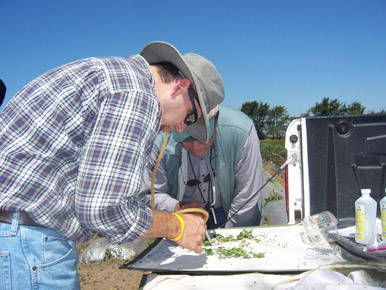
Researches look at alternatives to pesticides on farms
Research conducted on plots at the Agriculture and Land-Based
training association revealed a host of information that could
someday be used on San Benito farms. A chemical in black mustard
deters aphids in broccoli crops. Alfalfa can be used as a trap for
a bug that damages strawberries. And growers can stop spreading
nitrogen fertilizer before planting strawberries.
Researches look at alternatives to pesticides on farms
Research conducted on plots at the Agriculture and Land-Based training association revealed a host of information that could someday be used on San Benito farms. A chemical in black mustard deters aphids in broccoli crops. Alfalfa can be used as a trap for a bug that damages strawberries. And growers can stop spreading nitrogen fertilizer before planting strawberries.
Scientists from two University of California campuses presented findings on how crops can be managed with fewer chemicals Aug. 27. The presentation was part of a two-hour tour at the Agriculture and Land-Based Training Association, a nonprofit whose staff trains fieldworkers.
Rebecca Chaplin-Kramer, a doctoral student at the University of California, Berkeley conducted the research on aphids and broccoli.
In 2007, broccoli was worth more than $2.3 million in San Benito County, according to the county’s crop report.
“If you don’t keep on top of them, they just cover the whole plant,” said Paul Matulich, agricultural commissioner for San Benito County. “They will cause it to turn yellow faster than it should, leave holes, cause small scars in the broccoli.”
Plus, consumers do not like bugs on their food, Matulich said.
Farms that are surrounded by a natural environment tend to a wider variety of bugs. More bug species should mean more aphid predators and fewer aphids.
“I haven’t seen the resulting downtick in aphids that you would expect,” Chaplin-Kramer said.
The discrepancy led her to explore the relationship between aphids and black mustard, an invasive weed.
“Some people let entire fields go to mustard,” Chaplin-Kramer said.
That could be the problem.
Black mustard produces glucocinilates, a compound that builds up in aphids and deters or kills their predators, Chaplin-Kramer said.
It might be possible to use black mustard as an aphid trap, Chaplin-Kramer said.
Her goal is to figure out how much black mustard is enough.
The danger is that without enough black mustard the aphids would eat their way through it and move onto broccoli.
Two scientists from the Center for Agroecology and Sustainable Food Systems (CASFA), a program at the University of California, Santa Cruz, are wining the battle against another pest of local concern.
Lygus is a small, brown bug that causes $40 million worth of damage annually to California’s strawberry crops.
When lygus feed on the berries it causes deformed growth, referred to as cat faced, for the bulges that develop on either side of the fruit.
“They can devastate strawberry plants if they’re not controlled,” Matulich said. “It doesn’t take long. A lot of companies have people who walk the fields continuously and look for damage.”
Two researchers are studying ways to prevent that damage.
“Alfalfa is 10 times more attractive to the lygus than the strawberries,” said Sean Swezey, a researcher for CASFA.
Planted as a hedgerow, alfalfa can deter lygus from feeding on strawberries.
“Farmers generally don’t want to waste two or three rows by planting alfalfa, but I think it’s worth it,” said Florentino Collazo, the farmer whose plot is being experimented on.
Without using pesticides, his strawberries were higher quality than any other grower at ALBA, Collazo said.
Although they did not pursue the subject academically, researchers noticed that there was little difference in the amount of lygus bugs on conventional farms and organic farms that use alfalfa as a trap, said Diego Nieta, a staff research associate at CASFS.
There are added benefits.
Alfalfa supports Perestenus redictus, a parasitic bug that is harmful to lygus.
“The parasite grabs the lygus by the hind legs and sticks its stinger into the bug,” Swezey said. “The young lygus bug will walk away, but a day or too later it will have a tummy ache. A day or two later, within one molt, the parasitoid burst out of the lygus.”
Originally from Europe, Perestenus redictus was released in the United States about four years ago. Researchers are interested in releasing the bugs on strawberry farms and monitoring the results.
“The way we transport it is by lygus bug,” Swezey said. “We bring them a whole bunch of pests.”
Alfalfa also improves strawberry fertility by fixing nitrogen, Swezey said.
“Right now, we think about 2 percent of your field should be planted with alfalfa,” Swezey said.
On an organic farm, during mid-summer growers should use a bugvac on the alfalfa once or twice per week to suck up any lygus, Nieta said. They do not yet have a recommendation for conventional farms.
The alfalfa should be cut about three times per year, but only 50 percent at a time, Nieta said. If the alfalfa gets too big, it is hard to get rid of the lygus bugs that are inside the plant.
Joji Muramoto, a professor at the University of California, Santa Cruz is conducting a different line of research that will help strawberry growers use fewer chemicals
Applying the fertilizer nitrogen before planting did not increase the quantity of strawberries produced, according to his experiments, Muramoto said.
“You can feed nitrogen in more later months, March, April, May,” Muramoto said. “That’s when strawberries need it.”
Pre-plant nitrogen tends to wash away because strawberries are planted right before the rainy season, he said. The rest breaks down before the strawberries are big enough for it to be useful.
Doing away with pre-plant nitrogen did not affect the quality of the fruit, said Miguel Martinez, whose plot was experimented on.
“We keep an eye on the quality and the number, and it was the same,” Martinez said.









